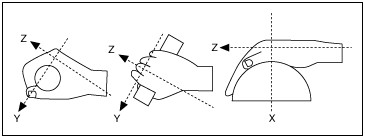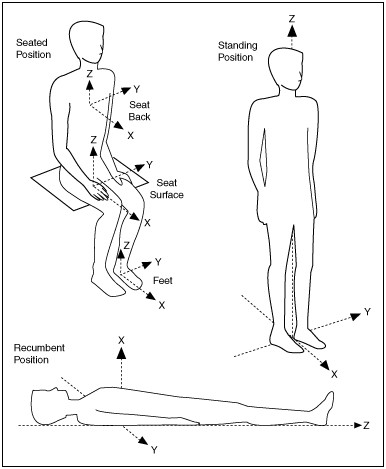Human Vibration Weighting Filters in LabVIEW Sound and Vibration Toolkit
Overview
This document discusses the use of human vibration weighting filters and their implementation using the NI LabVIEW Sound and Vibration Toolkit.
Human vibration refers to the effects of mechanical vibration on the human body. Excessive exposure to mechanical vibrations can negatively affect the human body. For example, exposure to whole-body vibration from operating machinery can lead to physical problems such as spinal disorders. Measuring and analyzing human vibration signals can help control the negative effects of mechanical vibration on the human body. The following list includes three types of human vibration signals that you might measure and analyze.
- Hand-arm vibration signals
- Whole-body vibration signals
- Low-frequency whole-body vibration signals.
The following illustration shows the coordinate system used to measure hand-arm human vibration, as defined by ISO 5348:1986.
The following illustration shows the coordinate system used to measure whole-body human vibration, as defined by ISO 2631–1:1997.
The NI LabVIEW Sound and Vibration Toolkit provides weighting filters that you can apply to human vibration signals. Applying weighting to human vibration signals can isolate the directional components that you are interested in and help you further analyze different types of human vibration.
The LabVIEW Sound and Vibration Toolkit provides the following weighting filters that you can apply to human vibration signals:
- Wb—Weighting for vertical whole-body vibration, z–axis, seated, standing or recumbent person, based on ISO 2631–4.
- Wc—Weighting for horizontal whole-body vibration, x–axis, seat back, seated person, based on ISO 2631-1.
- Wd—Weighting for horizontal whole-body vibration, x– or y–axis, seated, standing or recumbent person, based on ISO 2631-1.
- We—Weighting for rotational whole-body vibration, all directions, seated person, based on ISO 2631-1.
- Wf—Weighting for vertical whole-body vibration, z–axis motion sickness, seated or standing person, based on ISO 2631-1.
- Wh—Weighting for hand-arm vibration, all directions, based on ISO 5349-1.
- Wj—Weighting for vertical head vibration, x–axis recumbent person, based on ISO 2631-1.
- Wk—Weighting for vertical whole-body vibration, z–axis seated, standing or recumbent person, based on ISO 2631-1
- Wm—Weighting for whole-body vibration in buildings, all directions, based on ISO 2631-2.
Use the Wh weighting filter for hand-arm vibration signals. Use the Wb, Wc, Wd, We, Wj, Wk, and Wm weighting filters for whole-body vibration signals. Use the Wf weighting filter for low-frequency whole-body vibration signals.
Note: When combined with any DSA device, the human vibration weighting filters that the LabVIEW Sound and Vibration Toolkit provides comply with ISO 8041:2005 (E): Human Response to Vibration – Measuring Instrumentation.
Applying Human Vibration Weighting Filters
You can use the SVT Human Vibration Weighting Filter (Fixed Rates) VI, the SVT Human Vibration Weighting Filter (frequency) VI, and the SVT Human Vibration Weighting Filter (octave) VI to apply weighting to human vibration signals in both the time and frequency domains.
Use the SVT Human Vibration Weighting Filter (Fixed Rates) VI to apply weighting to time-domain signals. The following figure shows an example of applying weighting for hand-arm vibration, Wh, to time-domain signals.
In the previous figure, the SVL Scale Voltage to EU VI scales the time-domain signal. The SVT Human Vibration Weighting Filter (Fixed Rates) VI applies a Wh weighting to the scaled signal. The SVL RMS Level VI calculates the vibration level of the weighted signal.
The SVT Human Vibration Weighting Filter (Fixed Rates) VI supports fixed sampling rates when applying weighting to time-domain signals. The following table lists all the supported sampling rates:
| Applications | Weighting Filters | Supported Sampling Rates (Hz) |
| Hand-Arm | Wh | 8,000; 10,000; 12,500; 12,800; 16,666.666; 20,000; 25,000; 25,600; 33,333.333; 50,000; 51,200 |
| Whole-Body | Wb, Wc, Wd, We, Wj, Wk, Wm | 1,000; 2,000; 3,200; 4,000; 5,000; 6,400; 8,000; 10,000; 12,500; 12,800; 16,666.666; 20,000; 25,000; 25,600; 33,333.333; 50,000; 51,200 |
| Low-Frequency Whole-Body | Wf | 1,000; 2,000; 3,200; 4,000; 5,000; 6,400; 8,000; 10,000; 12,500; 12,800 |
Use the SVT Human Vibration Weighting Filter (frequency) VI and the SVT Human Vibration Weighting Filter (octave) VI to apply weighting to frequency-domain signals.
Use the SVT Human Vibration Weighting Filter (frequency) VI to apply weighting to FFT-based spectra. The following figure shows an example of applying weighting for hand-arm vibration, Wh, to FFT-based spectra.
Use the SVT Human Vibration Weighting Filter (octave) VI to apply weighting to octave spectra. The following figure shows an example of applying weighting for hand-arm vibration, Wh, to octave spectra:
The SVT Octave Spectrum Conversion VI converts the units of the weighted octave spectrum from power to magnitude.
Refer to the SVXMPL_Human Vibration (DAQmx) example VI in the labview\examples\Sound and Vibration\Vibration Level Measurements directory for an example of applying weighting to human vibration signals.




